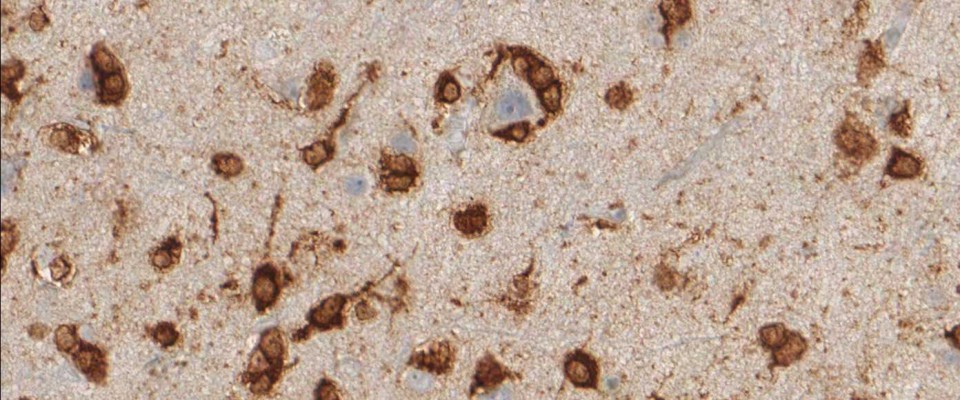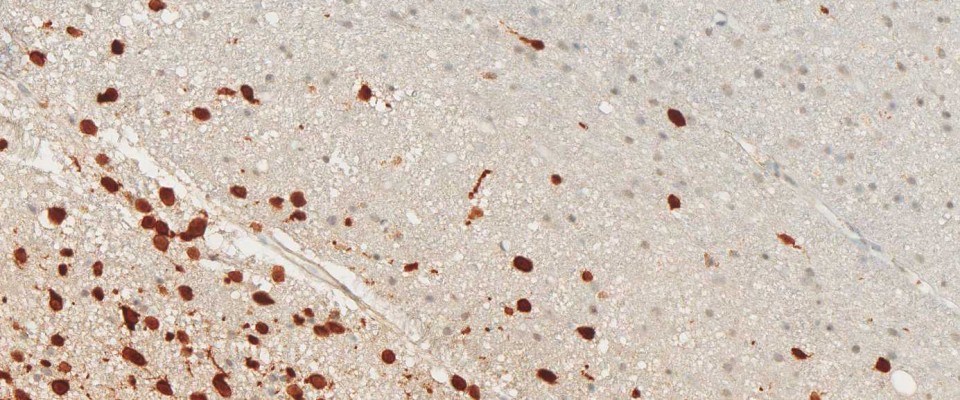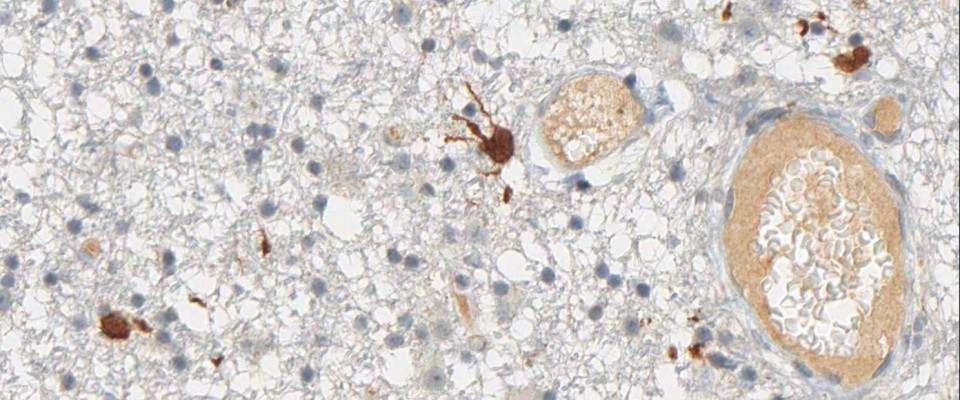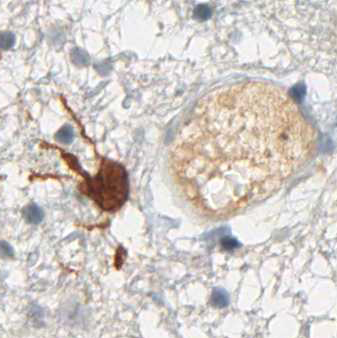Technical References
The immunohistochemical analysis of the IDH1 R132H mutation can be performed manually or by automated immunostaining procedures. The EURO-CNS research committee has proposed practical guidelines to standardize the IDH test and gives a detailed protocol recommendation for manual immunostaining and for automatic immunostaining on Ventana Benchmark immunostainers (Ventana Medical Systems, Tucson, AZ, USA) (1).
The National Comprehensive Cancer Network (NCCN), an alliance of 21 leading US cancer centers, and the EURO-CNS research committee recommend for optimal testing of the IDH1 mutation status in glioma to first perform immunohistochemical testing with the anti-IDH1 R132H antibody, then to follow up with DNA-sequencing only when the results from immunohistochemistry are negative (1, 2).
The sensitivity and specificity of the anti-IDH1 R132H antibody clone H09 to detect positive tumor cells has been widly demonstrated in several studies and allows satisfactory results in the routine immunohistochemistry of formalin-fixed, paraffin-embedded tissues (3).
| 1. | Preusser M, Capper D, Hartmann C. Euro-CNS Research Committee. IDH testing in diagnostic neuropathology: review and practical guideline article invited by the Euro-CNS research committee. Clin Neuropathol. 2011; 30(5):217-30. Review. |
| 2. | Febbo PG, Ladanyi M, Aldape KD, De Marzo AM, Hammond ME, Hayes DF, Lafrate AJ, Kelley RK, Marcucci G, Ogino S, Pao W, Sgroi DC, Birkeland ML. NCCN Task Force Report: Evaluating the Clinical Utility of Tumor Markers in Oncology. J Natl Compr Canc Netw. 2011 ; 9(5):1-32 |
| 3. | van den Bent MJ, Hartmann C, Preusser M, Ströbel T, Dubbink HJ, Kros JM, von Deimling A, Boisselier B, Sanson M, Halling KC, Diefes KL, Aldape K, Giannini C. Interlaboratory comparison of IDH mutation detection. J Neurooncol. 2013; 112(2):173-8. |
Scientific References
Role of IDH1 R132H as diagnostic marker
| 1. | Parsons et al. An integrated genomic analysis of human glioblastoma multiforme. Science. 2008; 321: 1807-1812. |
| 2. | Balss J et al. Analysis of the IDH1 codon 132 mutation in brain tumors. Acta Neuropathol. 2008; 116: 597-602. |
| 3. | Yan H et al. IDH1 and IDH2 mutations in gliomas. N Engl J Med. 2009; 360: 765-773. |
| 4. | Hartmann C et al. Type and frequency of IDH1 and IDH2 mutations are related to astrocytic and oligodendroglial differentiation and age: a study of 1,010 diffuse gliomas. Acta Neuropathol. 2009; 118: 469-474. |
| 5. | Korshunov A et al. Combined molecular analysis of BRAF and IDH1 distinguishes pilocytic astrocytoma from diffuse astrocytoma. Acta Neuropathol. 2009; 118: 401-405. |
| 6. | Mardis ER et al. Recurring mutations found by sequencing an acute myeloid leukemia genome. N Engl J Med. 2009; 361: 1058-1066. |
| 7. | Capper D et al. Monoclonal antibody specific for IDH1 R132H mutation. Acta Neuropathol. 2009;118: 599-601. |
| 8. | Capper D et al. Characterization of R132H mutation-specific IDH1 antibody binding in brain tumors. Brain Pathol. 2010; 20: 245-254. |
| 9. | Capper D et al. Application of mutant IDH1 antibody to differentiate diffuse glioma from nonneoplastic central nervous system lesions and therapy-induced changes. Am J Surg Pathol. 2010; 34: 1199-1204. |
| 10. | Camelo-Piragua S et al. Mutant IDH1-specific immunohistochemistry distinguishes diffuse astrocytoma from astrocytosis. Acta Neuropathol. 2010; 119: 509-511. |
| 11. | Capper D et al. Mutation-specific IDH1 antibody differentiates oligodendrogliomas and oligoastrocytomas from other brain tumors with oligodendroglioma-like morphology. Acta Neuropathol. Feb; 2011 121(2):241–252. |
| 12. | Horbinsky et al.Isocitrate dehydrogenase 1 analysis differentiates gangliogliomas from infiltrative gliomas.Brain Pathol. 2011;21(5):564-74. |
| 13. | Preusser et al. Value and limitations of immunohistochemistry and gene sequencing for detection of the IDH1-R132H mutation in diffuse glioma biopsy specimens. J Neuropathol Exp Neurol. 2011; 70: 715-723. |
| 14 | Pusch et al. Glioma IDH1 mutation patterns off the beaten track. Neuropathol Appl Neurobiol. 2011; 37(4):428-30. |
| 15. | Korshunov A et al. Combined molecular analysis of BRAF and IDH1 distinguishes pilocytic astrocytoma from diffuse astrocytoma. Acta Neuropathol. 2009; 118: 401-405. |
Role of IDH1 R132H as prognostic marker
| 1. | Hartmann C et al. Type and frequency of IDH1 and IDH2 mutations are related to astrocytic and oligodendroglial differentiation and age: a study of 1,010 diffuse gliomas. Acta Neuropathol. 2009; 118: 469-474. |
| 2. | Sanson M et al. Isocitrate dehydrogenase 1 codon 132 mutation is an important prognostic biomarker in gliomas. J Clin Oncol. 2009;27: 4150-4154. |
| 3. | Van den Bent MJ et al. IDH1 and IDH2 mutations are prognostic but not predictive for outcome in anaplastic oligodendroglial tumors: a report of the European Organization for Research and Treatment of Cancer Brain Tumor Group. Clin Cancer Res. 2010; 16: 1597-1604. |
| 4. | Weller M et al. Molecular predictors of progression-free and overall survival in patients with newly diagnosed glioblastoma: a prospective translational study of the German Glioma Network. J Clin Oncol. 2009; 27: 5743-5750. |
| 5. | Wick W et al. NOA-04 randomized phase III trial of sequential radiochemotherapy of anaplastic glioma with procarbazine, lomustine, and vincristine or temozolomide. J Clin Oncol. 2009; 27: 5874-5880. |
| 6. | Dubbink HJ et al. IDH1 mutations in low-grade astrocytomas predict survival but not response to temozolomide. Neurology. 2009; 73: 1792-1795. |
| 7. | Houillier C et al. IDH1 or IDH2 mutations predict longer survival and response to temozolomide in low-grade gliomas. Neurology. 2010; 75: 1560-1566. |
| 8. | Metellus P et al. Absence of IDH mutation identifies a novel radiologic and molecular subtype of WHO grade II gliomas with dismal prognosis. Acta Neuropathol. 2010; 120: 719-729. |
| 9. | Desestret V et al. Prognostic stratification of gliomatosis cerebri by IDH1(R132H) and IDH expression. J Neurooncol. 2011;105(2):219-24. |
| 10. | Preusser M et al. Prognostic value of Ki67 index in oligodendroglial tumors – a translational study of the European Organization for Research and Treatment of Cancer (EORTC) Brain Tumor Group. Histopathology 2012; 60(6):885-94. |
| 11. | Glas M et al., Group of The German Cancer Society FT. NOA-05 phase 2 trial of procarbazine and lomustine therapy in gliomatosis cerebri. Ann Neurol. 2011; 70(3):445-53. |
Role of IDH1 R132H as predictive marker
| 1. | Van den Bent MJ et al. IDH1 and IDH2 mutations are prognostic but not predictive for outcome in anaplastic oligodendroglial tumors: a report of the European Organization for Research and Treatment of Cancer Brain Tumor Group. Clin Cancer Res. 2010; 16: 1597-1604. |
| 2. | Weller M et al. Molecular predictors of progression-free and overall survival in patients with newly diagnosed glioblastoma: a prospective translational study of the German Glioma Network. J Clin Oncol. 2009; 27: 5743-5750. |
| 3. | Wick W et al. NOA-04 randomized phase III trial of sequential radiochemotherapy of anaplastic glioma with procarbazine, lomustine, and vincristine or temozolomide. J Clin Oncol. 2009; 27: 5874-5880. |
| 4. | Dubbink HJ et al. IDH1 mutations in low-grade astrocytomas predict survival but not response to temozolomide. Neurology. 2009; 73: 1792-1795. |
| 5. | Houillier C et al. IDH1 or IDH2 mutations predict longer survival and response to temozolomide in low-grade gliomas. Neurology. 2010; 75: 1560-1566. |
| 6. | Hartmann C et al. Patients with IDH1 wild type anaplastic astrocytomas exhibit worse prognosis than IDH1-mutated glioblastomas, and IDH1 mutation status accounts for the unfavorable prognostic effect of higher age: implications for classification of gliomas. Acta Neuropathol. 2010; 120:707-718. |
| 7. | Hartmann C et al. for the German Glioma Network. Molecular markers in low-grade gliomas: predictive or prognostic? Clin Cancer Res. 2011; 17: 4588-4599. |
| 8. |
Schuhmacher T et al. A vaccine targeting mutant IDH1 induces antitumour immunity. Nature 2014, DOI:10.1038/nature13387. |




